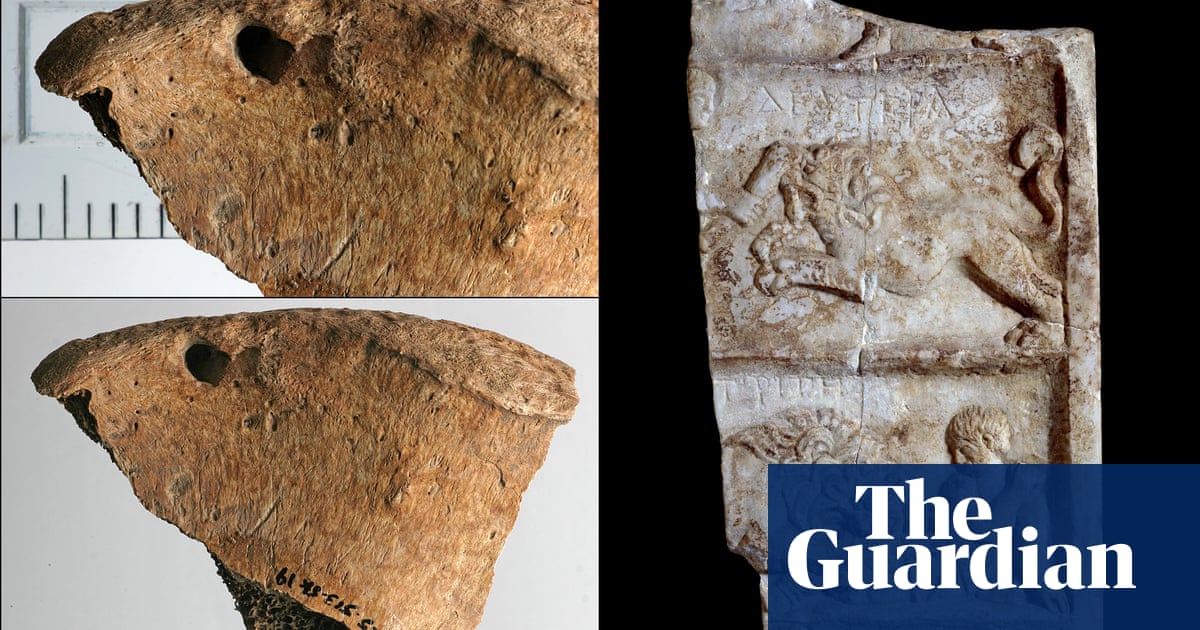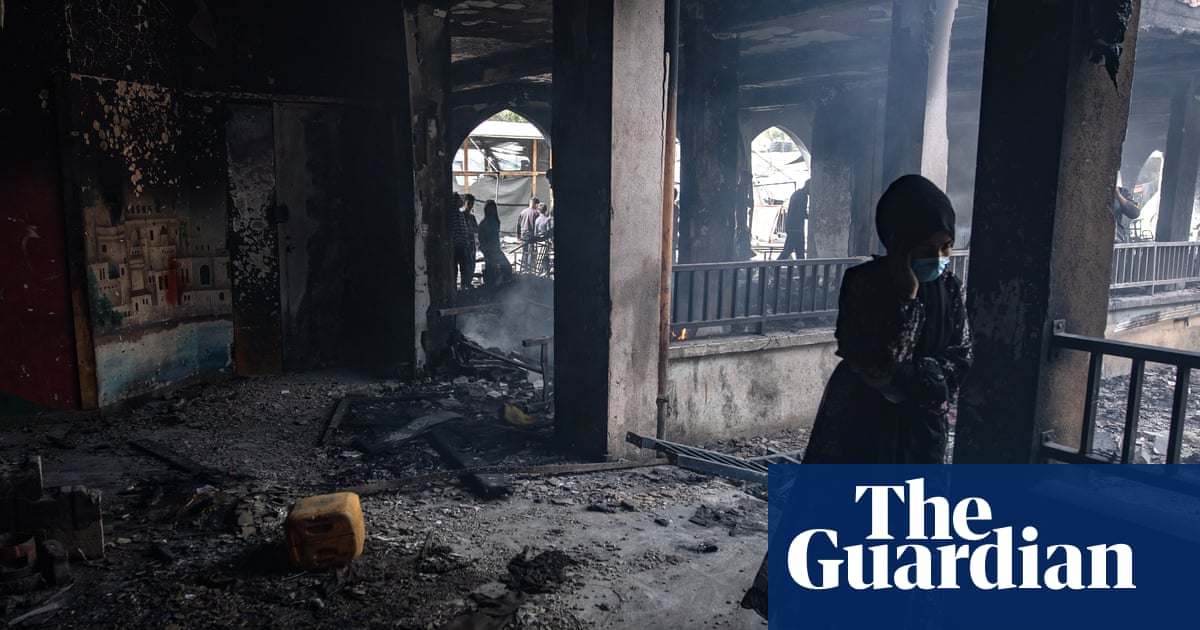When Sharren Bridges talks about her daughter’s last summer, in 2021, she chokes up and has to pause. In some ways, it was a good summer. Jen Bridges-Chalkley had a boyfriend and, like most parents of teenagers, Sharren would occasionally act as a taxi driver, taking them down to the local river to swim. “She spent time with her best friends and her godmother,” says Sharren. “And, looking back, she insisted on taking photographs with them and stuff like that.”
I am at Sharren’s house in Great Bookham in Surrey. We are sitting in the garden with the chickens and a couple of cockerels that haven’t yet learned the correct time of day to do their thing. Sharren works in the office of a homeless shelter and volunteers for Scouts and Guides; before that, she was a teaching assistant. Her mum, Chris – Jen’s grandma – brings out some tea.
Talking about Jen’s earlier childhood is less difficult for Sharren. She smiles as she alights on happy memories. Jen loved dancing, drama, animals and especially mermaids. Her favourite TV show was the Australian kids drama H2O: Just Add Water, about three girls who are mermaids. When she turned 16, Jen took up monofin freediving, “so she could be a mermaid, too. It scared the bejesus out of me,” says Sharren. Monofin freediving involves taking to the water with both feet in a single fanned blade, a bit like a mermaid’s tail, without an oxygen tank. “Apparently, it’s very meditative and calming.”
Jen’s parents split up when she was two, but otherwise Jen’s early years were stable. “If you looked into her box of life, she’s got a loving, supportive family, she lives in a nice area; it’s a fairly idyllic childhood,” says Sharren. “But that’s without seeing all the scaffolding and the Sellotape holding the box together.”
Jen lit a place up, says Sharren. “I’m not just saying that because she’s my daughter; she genuinely did. She made an impact wherever she went. I don’t know if that’s a good thing, but everyone remembers Jen, even her primary school teachers.” Sharren has a disability and Jen acted as a young carer. Her self-confidence and self‑esteem were always in short supply. “She saw good in everybody, but couldn’t see it in herself. And it’s like: ‘Darling, why can’t you see yourself how everyone else sees you?’ Because she is … she’s just amazing.”
Sharren often slips into the present tense when talking about her daughter. “Growing up …” Sharren begins. “Well, Jen never got to grow up.”

On 12 October 2021, Jen killed herself at her mother’s home. She was 17. At the inquest, which concluded in April 2024, the coroner said her suicide could have been avoided if she had received the support she needed “in a timely manner”. It was “a multi-agency failure”, he concluded in the report, which is a devastating document: 81 pages of missed opportunities, bad communication and poor decision-making.
“There was a failure of the agencies to work effectively together to ensure that Jen’s needs were met,” the coroner wrote. Safeguarding failure; failure by educational establishments; failure by child and adolescent mental health services (Camhs). “For much of the time between May 2018 and June 2020, she was on a waiting list for therapy from the psychology team and was awaiting assessment.” He concluded that Camhs had failed “properly to assess, diagnose and treat Jen … in order to manage her conditions and minimise her risk of suicide”.
Camhs is the NHS service for children with emotional, behavioural and mental health issues. Its staff includes psychiatrists, psychologists, nurses, therapists and social workers. It aims to provide support and treatment, including therapy, medication and in-hospital care. Sharren’s assessment of Camhs, provided in Jen’s case by Surrey and Borders Partnership NHS foundation trust, is simple: “It’s not fit for purpose.”
Jen was diagnosed with attention deficit hyperactivity disorder (ADHD) at 10 and with autistic spectrum disorder a year later. Both diagnoses had taken a long time. Sharren had originally approached her GP when Jen was five, then again when she was seven, suspecting she had ADHD (“autism was a bit of a shock,” Sharren says). Those diagnoses came from the paediatric team at Epsom general hospital.
In 2015, when Jen was 11, Sharren took her to the family GP, because she was self-harming by cutting her hair with a razor and restricting her diet. Jen was worried about her Sats exams, says Sharren, and her pending move to secondary school. Sharren told the GP: “Her mental health isn’t great; I don’t know what to do about it.” The GP referred Jen to Camhs for the first time, but the psychiatrist who triaged that referral said “no moderate to severe mental health issues were identified”.
Later that year, Jen moved to secondary school and struggled with the transition: the sheer number of people; the noise; the itchy uniform (Jen had sensory issues); the long days; homework and pressure. Jen was bullied. Sharren says she would often hang around at the end of a lesson to leave class with her teacher, “so she could walk out with a protector. Her self-esteem was knocked and knocked and knocked.”
Life was better out of school. Jen did ballet, horse riding, Scouts and Guides, where she had friends, many of them younger than her. When she moved into year 9 in September 2017, she started worrying about her GCSEs and her anxiety increased. She was not put on the special educational needs register for pupils who require extra provisions and there was no written plan for her, although she was given a “Be Aware” code, so teachers were aware of her needs. An education, health and care plan (EHCP) wasn’t put in place for her until 2019. This legal document, issued by local authorities, outlines a child’s special educational needs and disabilities and the support they require. It can be requested by schools and parents, although Sharren says she was never made aware of this.
The coroner highlighted the delay in the provision of an EHCP. He wrote that Jen’s special educational needs had been apparent since primary school; that there was a missed opportunity to issue a plan; and that her needs weren’t met. “This probably contributed to her rising anxiety and deteriorating self-esteem and mental state, including her suicidality,” he wrote.
At home, Jen began having angry outbursts. She struggled with eating and sleeping. From the age of 14, Sharren says, she started to talk about suicide. She was receiving regular check-in chats at school from her year manager, a staff member with a pastoral role. On 15 May 2018, Jen confided in her that she was planning to kill herself.
The year manager immediately phoned Camhs. Sharren and Jen attended a Camhs drop-in service that day. When asked by a mental health nurse what she thought the likelihood was of her acting on her plan to kill herself, Jen replied: “Nine and a half out of 10.” The referral was triaged as urgent.
In the following days, Jen was assessed at the Camhs centre by a mental health nurse. At a multidisciplinary discussion – a gathering of health professionals to discuss a patient’s case – it was decided that Camhs needed to liaise with the school to understand more about Jen’s needs, because suicidal ideation in an autistic child did not necessarily suggest a mental illness.
The consultant psychiatrist employed by Surrey and Borders trust, while accepting that the risk of suicide is higher in autistic children than in neurotypical children, told the coroner that an autistic child “might say they are suicidal; sometimes a family member might report that a young person is suicidal; a school may do similarly … That’s a term that has both specific and general usage, by which I mean it is not uncommon for an autistic child … to have limited use of language.
“So what we will often do is try and work out … is that literally: ‘I am suicidal, I am going to kill myself in relation to a specific mental health need,’ or is it an expression of distress that may be attributable to other needs, for example insufficient school support or other contextual factors.”

Sharren comments on this bluntly and sarcastically: “Yeah, autistic people often say they’re going to kill themselves, but they don’t mean it, because they don’t have the language skills.”
While acknowledging that traditional tools for suicide-risk screening are inadequate for people with autism (which can be because of communication differences), a US study last year into autism and suicidal thinking produced some alarming insights. Of the nearly 400 autistic children who reported wanting to die, 35% said this started at eight years old or younger. Of those experiencing such thoughts, 18% had a suicide planned.
After the assessment, Sharren says she assumed “we would see a doctor or a specialist of some sort and there’d be a plan, she would have some therapy. As Jen’s mum, I was overwhelmed, not knowing what the heck to do myself and trusting these people knew what they were doing.”
In fact, Jen didn’t go on the waiting list for therapy until four months later, on 18 September 2018. Jen was on that waiting list for much of the next two years.
In the meantime, they used the drop-in centre and had calls, by phone and in person, from Camhs mental health nurses. Jen had stopped going to school completely after the first referral. At the end of May, Jen had been visited at home by a Camhs primary mental health worker. Jen told her she was happier now that she had stopped going to school. The anxiety had decreased, but she was still experiencing panic attacks and thoughts of suicide.
The school decided Jen needed a different kind of educational provision. A place was found at a short-stay school for students with medical needs. “It was maybe three afternoons a week in a very small class, low sensory environment, the pace of learning wasn’t really high,” says Sharren.
Jen did well there, but the suicidal ideation didn’t go away. On four occasions between 2019 and 2021, when things got really bad and Jen said she didn’t feel safe at home, Sharren took her to A&E. Jen would be triaged, “then see a psychologist or psychiatrist, usually an adult one, because it was silly o’clock in the morning or really late, and then Jen was admitted to a generic children’s ward for her own safety”. It was always a generic ward – never a children’s psychiatric ward – and she was in for a couple of nights on each occasion.
When it came to discharging Jen, Sharren says staff would say: “‘We’ll make a discharge plan for her, she’ll see the crisis team, they will come and visit her and then we will try and get her to see a doctor in a few weeks’ time, once the crisis team has finished with her.’ That’s the cycle we kept going through.”
Except they didn’t get to see a doctor after a few weeks. “We didn’t actually see a doctor at any point apart from at A&E,” she says.
Jen was discharged with a safety plan involving follow-up calls from the crisis team, in person, on the phone and by video call. But she never saw a child psychiatrist. Not only was there no therapy, but there was no clear path to therapy. There was no appointed doctor who could get to know her and make a plan for sustained and consistent support.
“There was no communication between the doctors and that was really frustrating,” says Sharren. “The left hand doesn’t know what the right hand is doing: nobody seems to know anything, nothing is joined up, nothing marries. I’m not a doctor, I’m a mum, but I knew she needed to see somebody, because we had all these crisis interventions, we were waiting and waiting and waiting, the paediatric doctors knew she needed to see the Camhs doctors, but where is the gateway to Camhs? It’s an invisible place, where the unicorns and pixies live, it really is.”
Between hospital visits, Sharren encouraged Jen to use helplines and a Camhs drop-in. “But then she saw people from school at the drop-in, there with their own issues.” In Jen’s eyes, this meant the service was no longer safe for her. Meanwhile, her wait for therapy continued. Sharren couldn’t afford to go private: “It was close to £100 a session.”
An attempt in 2019 to go back to mainstream school didn’t go well. Jen’s anxiety increased even with short visits. Sharren found a place at another college for 14- to 16-year-olds who find it hard to cope in a mainstream setting, with smaller classes, core subjects in the morning, more vocational ones in the afternoon. Again, Jen did well. But then Covid hit. Jen struggled with online learning. Other things she enjoyed – like learning to freedive – also stopped.
Jen turned 16 in February 2020. There were boyfriends, alcohol, some drug use. The end of one relationship led to anxiety and panic attacks. Jen had problems sleeping, her self-esteem reached new lows and her personal hygiene suffered. At one point, she said she had become pregnant, but then had a miscarriage. (Sharren says this wasn’t true, but was “her way of screaming” for help.) Sharren and Jen fell out over one of Jen’s relationships and she moved in with her dad for a while. But Sharren says Jen would still phone her when she needed to: “She had physically moved out, but mentally she hadn’t.”
At 1.45am on 3 January 2021, Jen and her mum spoke to a Camhs crisis-call handler after Jen had attempted suicide. This led to the third Camhs referral. They were advised to go to A&E immediately, which they did. Jen was admitted to a children’s ward and in the morning she spoke to a mental health nurse working for the Community Crisis Intervention Service within Camhs, by video from the hospital. Jen had already seen the Psychiatric Liaison Service, which considered that she still presented as suicidal and unable to guarantee her own safety at home.
Later that day, it was decided that Jen would be discharged from hospital to her mother’s home, with a seven-day follow-up and a referral to a service that offers counselling to young people. She had come off the waiting list for therapy the last time she was discharged from Camhs in June 2020. No psychiatric review was suggested.
At the seven-day follow-up with the Camhs crisis team, again by video, Jen told the mental health nurse her mood was low and she got urges to self-harm but was feeling stable. Later in the month, a decision was taken for Jen to be discharged from the crisis team.

In June, Jen had a mental health review assessment, by video, with another mental health nurse employed by Camhs. Jen told him she was still struggling but was socialising more and making friends. “The sun was out,” says Sharren. “She and her dad had been to the beach, they were picking up a new puppy, everything was fine. But there are two versions of fine: there’s actually fine and there’s fine, I’m OK, but I’m not absolutely OK.”
After the assessment, Jen was discharged from Camhs. “Gone, bye-bye, everything’s fine, don’t worry about it, you’re good to go,” says Sharren, clearly seething. “She was basically left to fly solo, because everything was fine.”
Jen had been on a waiting list for therapy for about 18 months in total, between 2018 and 2020. Sharren loves the NHS, but thinks mental health, particularly children’s mental health, isn’t given sufficient priority: “You wouldn’t go to A&E with a broken leg for them to send you home to have a hot bath and a hot chocolate and cuddle with mummy and we’ll put you on a waiting list to fix your leg.”
Figures from NHS England in March 2024 showed that almost 1 million children and young people had active referrals for mental health services in 2022-23. Of these, 28% were still waiting for support, while 39% were assessed and not given support. In the year to March 2024, 40,000 children experienced a wait of at least two years.
In February 2024, a Guardian analysis of data from the Royal College of Psychiatrists (RCP) revealed that the number of children referred to Camhs crisis care in England had increased by 53% in three years. According to a separate review of NHS figures by the Guardian, 600 mentally ill children reach crisis point each week.
A workforce census published by the RCP in November found that 37% of child and adolescent consultant psychiatrist posts in England are vacant. In an interview at the time, Dr Lade Smith, the president of the RCP, told the Guardian the situation required immediate action from the government: “Chronic underfunding for over 15 years, alongside pressures on mental health services, has had a detrimental impact on the ability to recruit and retain enough psychiatrists.”
Sharren is angry when she speaks about Camhs. “Jen is a person, she’s my daughter, she’s my everything, and she’s not here any more because people didn’t do their job. They didn’t do their job when she was five, they didn’t do their job when she was 11, they didn’t do their job when she was 14, 15, 16, 17, and now she’s not going to get older than 17.”
In a statement, Graham Wareham, the chief executive of Surrey and Borders Partnership NHS foundation trust, said: “We remain deeply saddened by Jennifer’s tragic death and we have expressed our deepest condolences to her family. Our investigation into the support we provided Jennifer found that while we gave care and consideration into delivering a person-centred therapeutic approach to meet Jennifer’s mental health needs, we acknowledge that there were shortcomings.
“Jennifer received therapeutic support during the time she was under the care of the trust. She also received immediate support from our 24/7 mental health crisis services when needed. We recognise that there had been a referral for specialist psychology support that had not been delivered at the time of her agreed discharge. The waiting times for psychology at that time were not what we wanted for children and young people. Our waiting times for psychology are now significantly reduced to improve the experience for children, young people and their families.”
Somehow – I don’t know how – Sharren tells me about Jen’s last couple of days. Jen was staying with her boyfriend when she called Sharren. “It was late, past 11; I’d already gone to bed. She said: ‘Mummy, you need to come and pick me up.’ Every traffic diversion just happened to be there and it seemed to take a million times longer to get there than it should have done.”
Jen’s boyfriend lived with his mum. When Sharren went into the house, she found her daughter “unusually calm”: “She had everything orderly and folded – and Jen was not a child who folded things.”
On the drive home, Jen was texting her best friend. “I said: ‘Darling, do you think we need to go to the hospital? I can tell you’re not in a good place.’ And she said: ‘There’s no point going to the hospital – they never help, they never have, they never will.’ And so we got home and we had some really precious time together. I won’t go into the details, but I soothed her to sleep, as I did when she was at home before.”
In the morning, Sharren phoned Jen’s GP and got an appointment for the afternoon. Jen signed into college online. Sharren went to work in the afternoon. At the time, she was working as a teaching assistant at a primary school, but that day she was invigilating an exam at a different school. “I said: ‘Are you sure you’re going to be OK? I absolutely don’t have to go.’ And she said: ‘It’s fine.’ I asked my mum to pop in to check on her.”
At work, Sharren “had a horrible feeling that something had happened”. She got a message from the reception desk that the police were coming to pick her up. “That’s when I knew that feeling I’d had earlier was that Jen had died.
“I remember getting home and it was as if somebody had got a bag of police cars and ambulances and just tipped them out in the road.” She heard the boots of the police officers upstairs in Jen’s room. ‘“I remember thinking: ‘You’re not allowed boots upstairs, not on the carpet.’”
Since Jen died, Sharren has set up a charity called Jen’s Acorn, a programme of activities complementary to the school curriculum, “for less competent learners and those who need an alternative learning style”. She has also worked with Surrey county council on its autism strategy.
“I’ve just tried not to sink, really. I miss Jen desperately,” says Sharren. “Every day. I put on a face that everything’s OK, but I’m just a shell, a bit like an Easter egg. Wonderful on the outside, but inside there’s nothing.”
In the UK, the youth suicide charity Papyrus can be contacted on 0800 068 4141, or email [email protected]. In the UK and Ireland, Samaritans can be contacted on freephone 116 123, or email [email protected] or [email protected]. In the US, the National Suicide Prevention Lifeline is at 988, or chat for support. You can also text HOME to 741741 to connect with a crisis text line counselor. In Australia, the crisis support service Lifeline is on 13 11 14. Other international helplines can be found at befrienders.org
In the UK, the mental health charity Mind is available on 0300 123 3393 and Childline is on 0800 1111. In the US, call or text Mental Health America at 988, or chat 988lifeline.org. In Australia, support is available at Beyond Blue on 1300 22 4636, Lifeline on 13 11 14 and at MensLine on 1300 789 978

.png) 2 months ago
27
2 months ago
27













































